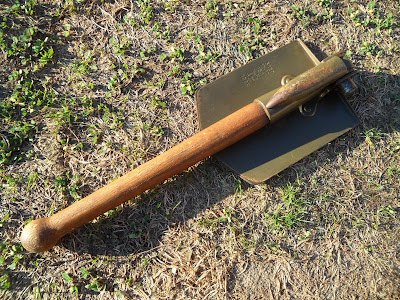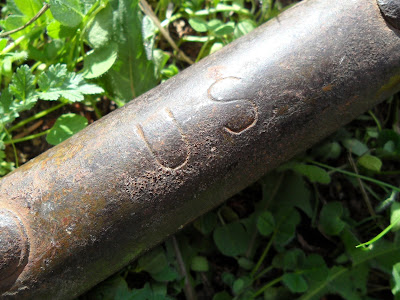UPDATE Nov. 2024: I don't usually start off a blog posting with an update, but in this instance I am. The shovel we'll be discussing is an interesting one, to say the least. My initial impression was that it was a WW1 version, but there were a few small differences from existing WW1 shovels, but enough similarities to call it WW1.......... After consulting, and discussing the shovel with a colleague of mine in Austria a number of years ago, and after more information and research was forwarded to me by another collector, it appears that the shovel is one of the VERY early, post WW1 shovels produced by Hungary. These early post war variations are nearly identical, and were made from 1945 to 1950. To date there does not seem to be any actual, concrete documentation on this, but collectors and a few shovel historians consider that to be "fact". These early post war shovels do not have the "blade ears", the top edge of the shank (where wood handle inserts) is rounded and not pointed like the WW1 version. It is interesting to note that the "shank band" on this shovel matches the bands on the M-1910 WW1 versions, and the rivets are ground flush like the M-1910 shovels. On the other 1945 - 1950 post-war shovels, the shank bands are thicker and narrower, and the rivets are proud. The 1945 -1950 versions also have the "1381" stamp with unknown makers mark.
There is a possibility that this shovel was reconditioned and put back into service, or could be some sort of transition shovel before the "normal" 1945 - 1950 shovels were standardized and put into full "mass production". Just a thought and observation........the answer is often in the little details!
So, for now we will have to call this shovel a 1945 - 1950, early post-war Hungarian spade. (I still find it very odd that they would reproduce the old WW1 shovels when so many better, and more modern styles were out there.....a mystery for sure!) If anyone can provide concrete information and documentation regarding this version, and what the markings positively mean, PLEASE let me know by email! Thanks again to everyone who has consulted and researched on this odd one.
I am leaving the original post as I wrote it at the time (2015), but please consider the information in the update as you read through it.
The Original Blog Post:
As promised, the shovel and spade thread continues! Up today is a recent addition to the collection that arrived in a very unexpected way. It is a WW1 vintage, Austro - Hungarian Trench Spade.
A while back, I purchased a post-war, Model 1950, Hungarian entrenching spade from one of my favorite surplus sources. Unfortunately they did not include the canvas shovel cover. I have have been looking for an original, correct, Hungarian cover to go with it ever since. Apparently they are tougher to find than I thought!
Then I caught a lucky break in the search. The same company was selling them again, only this time, they included the original canvas covers. The price was right, so I went ahead and ordered a second one, just to get the cover (and you can never have too many shovels!).


When the package arrived, I eagerly tore into it and pulled out a "ratty and beat" shovel in a mint condition cover. Not exactly what I was expecting. The shovel cover was everything I was hoping for. It was a mint condition and completely intact, post-war, Model 1950 Hungarian cover. Poking out of the cover was a very beat up shovel handle. I immediately noticed that the handle did not look at all "quite right". The wooden handle was too thin and too long for a Model 1950 shovel. It was also in noticeably rough shape. I pulled out the shovel and discovered that it was in fact, a pre-WW1 Austro - Hungarian Trench Spade! Technically it was Hungarian, but definitely NOT a post-war spade (as in post-WW2)! I unexpectedly had landed an unbelievable shovel score!

The spade is not in anywhere close to perfect condition, but it has that amazing patina that only 100 years and two wars worth of use can impart. The metal was "hot dipped" in a tar paint that had hardened and petrified, and the handle had been whittled, and carved with graffiti by previous owners.
I would imagine that this spade had been in use through WW1, then WW2, and then for some time after WW2, until the Model 1950 spades were issued out. Then the old shovels were discarded or placed into long-term storage by hot dipping in the tar paint and adding a new canvas cover. I just happened to be one of the lucky buyers who received one of the odd , old spades, in the surplus bin!
I could see a bit of some stampings under the tar paint.
A half an hour's worth of scrubbing with a green scouring pad and mineral spirits, and the tar paint was removed, leaving the original metal and finish intact. It appears that the blade had been used as a "frying pan" over an open fire for quite some time, leaving the metal with an interesting "Damascus" finish. The stamping marks came out clear as well, however, I still have not identified them.
The handle had been carved with two flats on the top and bottom so that it would grip correctly to use as a trench fighting "axe". At least one previous owner had carved his initials into the wood, with a few additional "decorations" as well.
All in all, this is an amazing example of a "real trench spade" from WW1. Beautiful in all of its imperfections!
Before we look at the album, here are a couple of photos comparing the Model 1950, post war spade, with the Model 1910, WW1 spade I received. The Model 1910 is on the top.
Here is the album, enjoy!
Pre-Cleaning:
After Cleaning:




















































